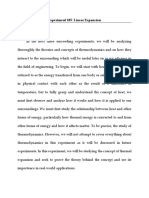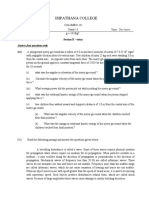The Effects of Heat
Uploaded by
Charish BonielThe Effects of Heat
Uploaded by
Charish BonielThe Effects of Heat
Change in temperature-
And as we all know, the temperature of the water will rise.
Temperature is a measure of the average kinetic energy of the
molecules within the water. You can think of temperature as an
expression of the "intensity" with which the thermal energy in a body
manifests itself in terms of chaotic, microscopic molecular motion.
Change in temperature is caused by weather disturbance.
Global surface temperature has increased ≈0.2°C per decade in the
past 30 years, similar to the warming rate predicted in the 1980s in
initial global climate model simulations with transient greenhouse gas
changes. Warming is larger in the Western Equatorial Pacific than in
the Eastern Equatorial Pacific over the past century, and we suggest
that the increased West–East temperature gradient may have
increased the likelihood of strong El Niños, such as those of 1983 and
1998. Comparison of measured sea surface temperatures in the
Western Pacific with paleoclimate data suggests that this critical ocean
region, and probably the planet as a whole, is approximately as warm
now as at the Holocene maximum and within ≈1°C of the maximum
temperature of the past million years. We conclude that global
warming of more than ≈1°C, relative to 2000, will constitute
“dangerous” climate change as judged from likely effects on sea level
and extermination of species.
Method Mixtures-
A method of determining the heat of fusion of a substance whose
specific heat is known, in which a known amount of the solid is
combined with a known amount of the liquid in a calorimeter, and the
decrease in the liquid temperature during melting of the solid is
measured.
Change of State-
In science, change in the physical state (solid, liquid, or gas) of a
material. For instance, melting, boiling, and evaporation and their
opposites, solidification and condensation, are changes of state. The
former set of changes are brought about by heating or decreased
pressure (except for the melting of ice, which is favoured by pressure);
the latter by cooling or increased pressure.
These changes involve the absorption or release of heat energy,
called latent heat, even though the temperature of the material does
not change during the transition between states. See also states of
matter. Changes of state can be explained by the kinetic theory of
matter. In the unusual change of state called sublimation, a solid
changes directly to a gas without passing through the liquid state. For
example, solid carbon dioxide (dry ice) sublimes to carbon dioxide gas.
Thermal expansion –
The tendency of matter to change in volume in response to a change
in temperature. All materials have this tendency. When a substance is
heated, its particles begin moving and become active thus maintaining
a greater average separation. Materials which contract with increasing
temperature are rare; this effect is limited in size, and only occurs
within limited temperature ranges. The degree of expansion divided by
the change in temperature is called the material's coefficient of
thermal expansion and generally varies with temperature.
Heat Transfer –
Heat transfer, also known as heat flow, heat exchange,
or transfer of thermal energy is the movement of heat from one
place to another. When an object is at a different temperature from its
surroundings, heat transfer occurs so that the body and the
surroundings reach the same temperature at thermal equilibrium. Such
spontaneous heat transfer always occurs from a region of high
temperature to another region of lower temperature as required by
the second law of thermodynamics.
In engineering, energy transfer by heat between objects is classified as
either heat conduction, also called diffusion, of two objects in contact,
by fluid convection, which is the mixing of hot and cold fluid regions,
and by thermal radiation, the transmission of electromagnetic
radiation described by black body theory. However, engineers also
consider the transfer of mass of differing chemical species, either cold
or hot, to achieve transfer of heat.
* Conduction- On a microscopic scale, heat conduction occurs as
hot, rapidly moving or vibrating atoms and molecules interact with
neighboring atoms and molecules, transferring some of their energy
(heat) to these neighboring atoms. In other words, heat is transferred
by conduction when adjacent atoms vibrate against one another, or as
electrons move from one atom to another. Conduction is the most
significant means of heat transfer within a solid or between solid
objects in thermal contact. Fluids (and especially gases) are less
conductive. Thermal contact conductance is the study of heat
conduction between solid bodies in contact.
Steady state conduction is a form of conduction which happens when
the temperature difference driving the conduction is constant so that
after an equilibration time, the spatial distribution of temperatures in
the conducting object does not change any further. In steady state
conduction, the amount of heat entering a section is equal to amount
of heat coming out.
Transient conduction occurs when the temperature within an object
changes as a function of time. Analysis of transient systems is more
complex and often calls for the application of approximation theories,
and/or numerical analysis by computer.
* Convention- Convective heat transfer is the transfer of heat
from one place to another by the movement of fluids. The presence of
bulk motion of the fluid enhances the heat transfer between the solid
surface and the fluid.[3] Convection is usually the dominant form of heat
transfer in liquids and gases. Although often discussed as a third
method of heat transfer, convection actually describes the combined
effects of conduction and fluid flow.
Free or natural convection occurs when the fluid motion is caused by
buoyancy forces that result from the density variations due to
variations of temperature in the fluid. Forced convection is when the
fluid is forced to flow over the surface by external sources such as
fans, stirrers, and pumps, creating an artificially induced convection
current.[4]
Convection is described by Newton's law of cooling, which states
that the rate of heat loss of a body is proportional to the difference in
temperatures between the body and its surroundings.
*Radiation- Thermal radiation is the transfer of heat energy
through empty space by electromagnetic waves. All objects with a
temperature above absolute zero radiate energy. No medium is
necessary for radiation to occur, for it is transferred by
electromagnetic waves; radiation takes place even in and through a
perfect vacuum. For instance, the energy from the Sun travels through
the vacuum of space before warming the earth. Radiation is the only
form of heat transfer that can occur in the absence of any form of
medium (i.e., through a vacuum).
Thermal radiation is a direct result of the movements of atoms and
molecules in a material. Since these atoms and molecules are
composed of charged particles (protons and electrons), their
movement results in the emission of electromagnetic radiation, which
carries energy away from the surface. At the same time, the surface is
constantly bombarded by radiation from the surroundings, resulting in
the transfer of energy to the surface. Since the amount of emitted
radiation increases with increasing temperature, a net transfer of
energy from higher temperatures to lower temperatures results.
Unlike conductive and convective forms of heat transfer, thermal
radiation can be concentrated in a tiny spot by using reflecting mirrors.
Concentrating solar power takes advantage of this fact. For example,
the sunlight reflected from mirrors heats the PS10 solar power tower,
and during the day it can heat water to 285 °C (558.15 K) or 545 °F.
Thermodynamics
Zeroth Law-
The zeroth law of thermodynamics is a generalization principle of
the thermal equilibrium among bodies, or thermodynamic systems, in
contact. Systems are in thermal equilibrium if they do not exchange
energy in the form of heat.
The zeroth law states that if two systems are in thermal equilibrium
with a third system then they are also in thermal equilibrium with each
other.
This means that thermal equilibrium is transitive and it affords the
definition of an empirical physical parameter, called temperature,
which is the same for all systems in thermal equilibrium. The law
permits the construction of a thermometer to measure this property.
We use the zeroth law when we wish to compare the temperatures of
two objects, A andB. We can do this by using a thermometer, C and
placing it again object A it reaches thermal equilibrium with
object A and measure the temperature of A. Placing the thermometer
against object B until thermal equilibrium is reached we measure the
temperature of object B. If they are the same temperature then they
will be in thermal equilibrium with each other.
First law-
The first law of thermodynamics is an expression of the principle
of conservation of energy.
The law expresses that energy can be transformed, i.e. changed from
one form to another, but cannot be created or destroyed. It is usually
formulated by stating that the change in the internal energy of a
system is equal to the amount of heat supplied to the system, minus
the amount of work performed by the system on its surroundings.
It is typical for chemistry texts to write the first law as ΔU=Q+W. It is
the same law, of course - the thermodynamic expression of the
conservation of energy principle. It is just that W is defined as the work
done on the system instead of work done by the system. In the context
of physics, the common scenario is one of adding heat to a volume of
gas and using the expansion of that gas to do work, as in the pushing
down of a piston in an internal combustion engine. In the context of
chemical reactions and process, it may be more common to deal with
situations where work is done on the system rather than by it.
Second Law-
The second law is an expression of the fact that over time, differences
in temperature, pressure, and chemical potential tend to balance out in
an isolated physical system. The second law may be expressed in
many ways, but they all have the same effect of explaining the
phenomenon of irreversibility in nature.
In classical thermodynamics, the second law is a basic postulate
applicable to any system involving measurable heat transfer, while
in statistical thermodynamics, the second law is afundamental
postulate of the assumed randomness of molecular chaos.
The second law of thermodynamics is a general principle which places
constraints upon the direction of heat transfer and the attainable
efficiencies of heat engines. In so doing, it goes beyond the limitations
imposed by the first law of thermodynamics. It's implications may be
visualized in terms of the waterfall analogy.
Third Law-
The third law of thermodynamics is a statistical law of nature
regarding entropy and the impossibility of reaching absolute zero, the
null point of the temperature scale. The most common enunciation of
the third law of thermodynamics is:
As a system approaches absolute zero, all processes cease and
the entropy of the system approaches a minimum value.
This minimum value, the residual entropy, is not necessarily
zero, although it is almost[2] always zero in a perfect, pure crystal.
In simple terms, the third law states that the entropy of most pure
substances approaches zero as the absolute temperature approaches
zero. This law provides an absolute reference point for the
determination of entropy. The entropy determined relative to this point
is the absolute entropy.
A special case of this is systems with a unique ground state, such as
most crystal lattices. The entropy of a perfect crystal lattice as defined
by Nernst's theorem is zero (if its ground state is singular and unique,
whereby log(1) = 0). An example of a system which does not have a
unique ground state is one containing half-integer spins, for
which time-reversal symmetry gives two degenerate ground states. Of
course, this entropy is generally considered to be negligible on a
macroscopic scale. Additionally, other exotic systems are known that
exhibit geometrical frustration, where the structure of the crystal
lattice prevents the emergence of a unique ground state.
Real crystals with frozen defects obey this same law, so long as one
considers a particular defect configuration to be fixed. The defects
would not be present in thermal equilibrium, so if one considers a
collection of different possible defects, the collection would have some
entropy, but not actually have a temperature. Such considerations
become more interesting and problematic in considering various forms
of glass, since glasses have large collections of nearly degenerate
states, in which they become trapped out of equilibrium.
Another application of the third law is with respect to the magnetic
moments of a material. Paramagnetic materials (moments random) will
order as T approaches 0 K. They may order in a ferromagnetic sense,
with all moments parallel to each other, or they may order in an ant
ferromagnetic sense, with all neighboring pairs of moments antiparallel
to each other. (A third possibility is spin glass, where there is residual
entropy.)
Yet another application of the third law is the fact that at 0 K no solid
solutions should exist. Phases in equilibrium at 0 K should either be
pure elements or atomically ordered phases.
You might also like
- Experiment 6: Heat Effects Laboratory ReportNo ratings yetExperiment 6: Heat Effects Laboratory Report9 pages
- Engineering Heat and Mass Transfer: Fig. 1.1. (A) Forced Convection of Air (T T)No ratings yetEngineering Heat and Mass Transfer: Fig. 1.1. (A) Forced Convection of Air (T T)2 pages
- Thermal Physics – Phase Change, Heat Transfer, Introduction to ThermodynamicsNo ratings yetThermal Physics – Phase Change, Heat Transfer, Introduction to Thermodynamics7 pages
- Thermal Engineering Thermal Energy Heat Thermal Conduction Thermal Convection Thermal Radiation Phase ChangesNo ratings yetThermal Engineering Thermal Energy Heat Thermal Conduction Thermal Convection Thermal Radiation Phase Changes1 page
- Unit - 1: (B) Difference Between Thermodynamcis and Heat Transfer100% (1)Unit - 1: (B) Difference Between Thermodynamcis and Heat Transfer66 pages
- 2.1. Fundamentals of Heat Transfer and Thermodynamics 2.1.1. ThermodynamicsNo ratings yet2.1. Fundamentals of Heat Transfer and Thermodynamics 2.1.1. Thermodynamics5 pages
- Convection: Convection Is The Concerted, CollectiveNo ratings yetConvection: Convection Is The Concerted, Collective12 pages
- Heat Transfer: From (Non-Conventional Energy Sources (OE-ME 701D) Continuous Assessment 2 (CA 2)No ratings yetHeat Transfer: From (Non-Conventional Energy Sources (OE-ME 701D) Continuous Assessment 2 (CA 2)44 pages
- Unit: 1 Refrigeration System and Refrigeration EquipmentsNo ratings yetUnit: 1 Refrigeration System and Refrigeration Equipments13 pages
- CHE333 - Shell Energy Transfer 2023 - 2024No ratings yetCHE333 - Shell Energy Transfer 2023 - 202436 pages
- Heat Transfer by Conduction and Convection, Lab Report100% (1)Heat Transfer by Conduction and Convection, Lab Report34 pages
- Chemical Engineering For Non-Chemical Engineers - Vol. 02 - DHARMSINH DESAI UNIVERSITYNo ratings yetChemical Engineering For Non-Chemical Engineers - Vol. 02 - DHARMSINH DESAI UNIVERSITY150 pages
- Module 1: Introduction To Heat TransferNo ratings yetModule 1: Introduction To Heat Transfer168 pages
- Transmission of Heat and Its ApplicationNo ratings yetTransmission of Heat and Its Application21 pages
- Analysis of Heat Transfer Through Fins of Ic Engine: August 2019No ratings yetAnalysis of Heat Transfer Through Fins of Ic Engine: August 201912 pages
- The Accountancy Profession and Its DevelopmentNo ratings yetThe Accountancy Profession and Its Development23 pages
- The Accountancy Profession and Its DevelopmentNo ratings yetThe Accountancy Profession and Its Development23 pages
- Mechanical Engineering Department: PPT On Fluid MachineryNo ratings yetMechanical Engineering Department: PPT On Fluid Machinery111 pages
- Steam Turbine Modeling: 10.1 Basic DescriptionNo ratings yetSteam Turbine Modeling: 10.1 Basic Description13 pages
- Analytical Solution of Unsteady Couette Flow Using Heat Equation - Poster NO - 5No ratings yetAnalytical Solution of Unsteady Couette Flow Using Heat Equation - Poster NO - 51 page
- Structural Elements Design Manual !!!!!!!!!!!!!mico999@No ratings yetStructural Elements Design Manual !!!!!!!!!!!!!mico999@244 pages
- Diffusion Coefficient and Viscosity Relationship and ImpactsNo ratings yetDiffusion Coefficient and Viscosity Relationship and Impacts1 page
- Isipathana College Physics: Answer Four Questions OnlyNo ratings yetIsipathana College Physics: Answer Four Questions Only11 pages
- Mechanical Control of Wind Turbine: Payal Gupta Advisor: Dr. Ovidiu CrisanNo ratings yetMechanical Control of Wind Turbine: Payal Gupta Advisor: Dr. Ovidiu Crisan22 pages
- C Purlin Design Calculation With Single Sag Rods: y 2 3 3 3 3 3 6 4 Y-Y X-XNo ratings yetC Purlin Design Calculation With Single Sag Rods: y 2 3 3 3 3 3 6 4 Y-Y X-X1 page
- JORDAHL® EXPERT Punching Shear - Design 1. Input InformationNo ratings yetJORDAHL® EXPERT Punching Shear - Design 1. Input Information4 pages
- Handout 3 - Floor Strengthening Using New JoistsNo ratings yetHandout 3 - Floor Strengthening Using New Joists9 pages




























































































